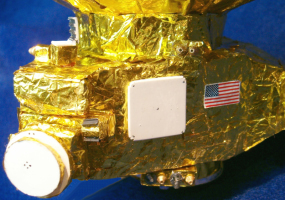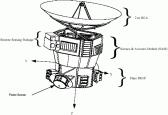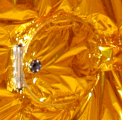


“We Support a Mission to Pluto” Campaign Button,
used to create a link to the petition web site
The Model










This is the image that was my early standard for building the model. I also utilized the Revision 12 PDF file that was published on the web (which was fairly accurate, though it also led me down a lot of wrong paths). You can downolad that here. As more photos became available of the actual spacecraft, I was forced to rebuild several features of the model.

In the perpetual gloom at the fringe of the outer solar system, the New Horizons spacecraft skims over Pluto. In the background, Charon is a cresent moon and the Sun is a distant, dim star.
The Spacecraft
Early Concepts
As with most space vehicles, the New Horizons design went through several
different stages of evolution. The two most famous early concepts are shown here:



This was to be a micro probe, weighing in at a mere 260 pounds!
The final spacecraft configuration, however, resembled this
fairly closely, only on a much larger scale


These are the best illustrations I’ve found of the final, flight configuration of the spacecraft.
The Instruments of Science

|
|
 |
|
|
|
 |
|
|
|
 |
|
|
Reconnaissance Imager |
 |
This system will snap long-range photos of Pluto, Charon, and KBOs prior to and during closest approach |
|
Around Pluto |
 |
|
|
Particle Spectrometer Science Investigation |
 |
|
|
(SDC) |
 |
It will measure space dust impacting the spacecraft throughout its mission |
